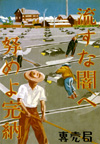![]()
![]()
 The
Confusion Era:
The
Confusion Era:
Art and Culture of Japan During the Allied Occupation, 1945-1952
 Foreword to the print edition
Foreword to the print edition
by MILO CLEVELAND BEACH
The Allied Occupation, immediately following the end of the Second World War, witnessed profound American involvement in virtually every aspect of life in Japan, forever changing the dynamic between the countries. Numerous studies addressing politics, economic and constitutional development, and education reform have been published but little has been written concerning the conditions of the arts during this formative era. As the world marks a half century since the events of the Occupation, it is time to reflect on the creative environment that affected the cultural and social life of the country. The Confusion Era: Art and Culture of Japan During the Allied Occupation, 1945-1952, brings together an eminent, lively group of authors for a critical exploration of the achievements and experiments of this crucial time.
Film historian and writer Donald Richie's "The Occupied Arts" probes the ironies, missteps, and politics of the Occupation censors and their new colleagues in the Japanese cultural community. Citing incidents both famous and infamous, the essay deftly touches on painting, theater, and film, including such examples as Kurosawa Akira's They Who Step on the Tiger's Tail (Tora no o o fumu otokotachi)--which was prohibited by the Japanese authorities as too democratic, then banned by the American authorities as too feudalistic, and the release of the film had to wait until the end of the Occupation.
Artist Kitawaki Noboru's Quo Vadis (1949) depicts a man uncertain of which way to go; a long queue of people stirs memories of lines of soldiers, or captives, while the blue of the sky suggests endless emptiness. This painting mirrors the absorbing issues facing visual artists who not only suffered reversals of fortune during the war but also a fundamental confusion of values in the aftermath. Many venerable' artistic approaches fell into disrepute after the war. Some artists actively sought an international style, while others attempted to overcome the harsh realities of daily existence through heroic acts of expression. In a revealing look at nine artists, Emiko Yamanashi surveys the results of the caution and experimentation of the era.
Keiko I. McDonald examines the conflicted and provocative evolution of women's roles in film in her essay "Whatever Happened to Passive Suffering?" while Linda C. Ehrlich discusses two films by Japanese directors looking back on the period. The Americans were attempting to instill new values--for example, by promoting "the individual" as opposed to the traditional Japanese focus on "the group." Democracy was "everywhere," but no one could be sure what it would mean for the Japanese as when, in one film scene, a student nervously responds to the new prescription for coed classrooms with the question: "Is that democracy?"
Emergency food and health announcements had to be printed
despite extreme shortages so severe that locating sheets of paper large
enough for posters required extraordinary effort. In tandem, production
of posters for movie and commercial advertising never ceased either. Some
of the paper was of such poor quality that only the ink used in the lithographic
process held it together. Ranging in purpose from soliciting donations of
clothes to promoting cosmetics and "Peace Cigarettes," a selection
of posters forms a portfolio, assembled by James Howard Fraser.
This chapter and its portfolio of posters are featured on this site.
See "Don't Sell Salt Illegally:
Posters in Occupied Japan," James Howard Fraser.
Closely connected with American efforts to foster Japanese cultural patrimony during the months immediately after surrender, Sherman E. Lee provides a telling first-person account of his experiences during those difficult years. His job with the Arts and Monuments Division of the Supreme Commander of the Allied Powers (SCAP) in Tokyo led him to inspection visits of temple sites and art collections in many parts of Japan at a time of intense national scrutiny.
The Allied Occupation of Japan was the bridge between a
period of wartime distrust and carnage and today's productive, culturally
rich interdependence. The Confusion Era is the first in "Asian
Art & Culture," a series of books that integrate the perspectives
of writers, art and cultural historians, artists, and literary scholars
on critical themes in Asian art and culture.

![]() Go to "Don't Sell Salt Illegally:
Posters in Occupied Japan"
Go to "Don't Sell Salt Illegally:
Posters in Occupied Japan"
courtesy of the Smithsonian Institution